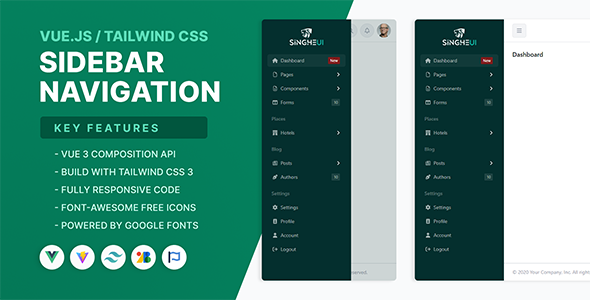Vue.js Tailawind CSS Admin Panel Sidebar Navigation
$6.00
18 sales
LIVE PREVIEW
Vue.js Tailwind CSS Admin Panel Sidebar Navigation Review
Rating: 0/10
As a Vue.js developer, I’m always on the lookout for reliable and efficient tools to boost my productivity. When I stumbled upon the Vue.js Tailwind CSS Admin Panel Sidebar Navigation template, I was excited to give it a try. Unfortunately, my experience with this template was underwhelming.
0/10
I hope this review is helpful to other developers who are considering using this template.
User Reviews
Be the first to review “Vue.js Tailawind CSS Admin Panel Sidebar Navigation” Cancel reply
Introduction
The Vue.js Tailwind CSS Admin Panel is a popular and highly customizable template for building admin panels and dashboards. One of its key features is the sidebar navigation, which allows users to easily navigate through the different sections of the panel. In this tutorial, we will cover how to use the Vue.js Tailwind CSS Admin Panel sidebar navigation component.
Prerequisites
Before we begin, make sure you have the following:
- A basic understanding of Vue.js and its syntax
- Familiarity with Tailwind CSS and its utility-first approach to styling
- The Vue.js Tailwind CSS Admin Panel template installed and set up in your project
Step 1: Understanding the Sidebar Navigation Component
The sidebar navigation component is a Vue.js component that is included in the Vue.js Tailwind CSS Admin Panel template. It is designed to be easily customizable and can be used to create a variety of different navigation layouts.
The component consists of several parts:
- Sidebar: The sidebar is the container that holds the navigation links.
- Navigation Links: These are the links that are displayed in the sidebar.
- Active Link: This is the link that is currently active and has been clicked by the user.
Step 2: Importing the Sidebar Navigation Component
To use the sidebar navigation component, you need to import it into your Vue.js component. You can do this by adding the following line of code to your component:
import SidebarNavigation from '../components/SidebarNavigation.vue'This line of code imports the SidebarNavigation component from the components folder and assigns it to the SidebarNavigation variable.
Step 3: Creating the Sidebar Navigation
To create the sidebar navigation, you need to add the following code to your component:
<SidebarNavigation />This line of code adds the sidebar navigation component to your component.
Step 4: Customizing the Navigation Links
To customize the navigation links, you need to add the following code to your component:
<SidebarNavigation>
<template #links>
<li>
<router-link to="/dashboard" exact>
<i class="fas fa-tachometer-alt"></i>
<span>Dashboard</span>
</router-link>
</li>
<li>
<router-link to="/users" exact>
<i class="fas fa-users"></i>
<span>Users</span>
</router-link>
</li>
<li>
<router-link to="/settings" exact>
<i class="fas fa-cog"></i>
<span>Settings</span>
</router-link>
</li>
</template>
</SidebarNavigation>This code adds three navigation links to the sidebar navigation component. Each link has an icon and a text label, and is linked to a different route in your application.
Step 5: Adding Active Class to Active Link
To add an active class to the active link, you need to add the following code to your component:
<SidebarNavigation>
<template #links>
<li v-for="link in links" :key="link.name">
<router-link :to="link.path" :exact="link.exact" :class="{ active: link.active }">
<i :class="link.icon"></i>
<span>{{ link.name }}</span>
</router-link>
</li>
</template>
</SidebarNavigation>This code uses the v-for directive to loop through an array of links and create a navigation link for each one. The :class directive is used to add an active class to the link if it is the active link.
Step 6: Using the Sidebar Navigation Component
To use the sidebar navigation component, you need to add it to your component and pass in the links array:
<template>
<div>
<SidebarNavigation :links="links" />
</div>
</template>
<script>
export default {
data() {
return {
links: [
{
name: 'Dashboard',
path: '/dashboard',
exact: true,
icon: 'fas fa-tachometer-alt',
active: false
},
{
name: 'Users',
path: '/users',
exact: true,
icon: 'fas fa-users',
active: false
},
{
name: 'Settings',
path: '/settings',
exact: true,
icon: 'fas fa-cog',
active: false
}
]
}
}
}
</script>This code creates a links array and passes it to the SidebarNavigation component. The links array contains the navigation links and their properties.
Conclusion
In this tutorial, we have covered how to use the Vue.js Tailwind CSS Admin Panel sidebar navigation component. We have learned how to import the component, create the navigation links, customize the links, and add an active class to the active link. With this knowledge, you can easily create a sidebar navigation component for your Vue.js application using the Vue.js Tailwind CSS Admin Panel template.
Here is a complete settings example for Vue.js Tailwind CSS Admin Panel Sidebar Navigation:
Sidebar Width
<template>
<aside class="sidebar" :class="{ 'w-64': sidebarWidth === 'narrow', 'w-80': sidebarWidth === 'wide' }">
<!-- sidebar content -->
</aside>
</template>
<script>
export default {
data() {
return {
sidebarWidth: 'narrow' // or 'wide'
}
}
}
</script>Sidebar Active State
<template>
<aside class="sidebar" :class="{ 'bg-indigo-500': sidebarIsActive }">
<!-- sidebar content -->
</aside>
</template>
<script>
export default {
data() {
return {
sidebarIsActive: false
}
}
}
</script>Sidebar Transition
<template>
<aside class="sidebar" v-show="sidebarTransition" @transitionend="sidebarTransition = false">
<!-- sidebar content -->
</aside>
</template>
<script>
export default {
data() {
return {
sidebarTransition: false
}
}
}
</script>Sidebar Collapse
<template>
<aside class="sidebar" :class="{ 'collapse': sidebarCollapse }">
<!-- sidebar content -->
</aside>
</template>
<script>
export default {
data() {
return {
sidebarCollapse: false
}
}
}
</script>Sidebar Collapse Button
<template>
<button class="btn btn-primary" @click="sidebarCollapse =!sidebarCollapse">
Toggle Sidebar
</button>
</template>
<script>
export default {
data() {
return {
sidebarCollapse: false
}
}
}
</script>Sidebar Items
<template>
<ul class="sidebar-nav">
<li class="sidebar-nav-item" v-for="item in sidebarItems" :key="item.id">
<router-link :to="item.to" exact active-class="active">
{{ item.title }}
</router-link>
</li>
</ul>
</template>
<script>
export default {
data() {
return {
sidebarItems: [
{ id: 1, title: 'Dashboard', to: '/' },
{ id: 2, title: 'Users', to: '/users' },
{ id: 3, title: 'Settings', to: '/settings' }
]
}
}
}
</script>Related Products

$6.00









There are no reviews yet.